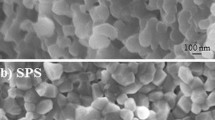Abstract
The effect of thermal wave at the initial stage for non-conductive Al2O3 powders compact in field assisted sintering technique (FAST) was investigated. The Lord and Shulman type generalized thermoselastic theory was introduced to describe the influence of thermal-mechanical interaction, as well as the heat transport and thermal focusing caused by thermal wave propagation. The expression of vacancy concentration difference of the particles was deduced by considering transient thermal stress. Subsequently, the relationship between activation energy and vacancy concentration difference was obtained. The mechanism of surface diffusion, volume diffusion, simultaneous surface and volume diffusion was analyzed. The numerical simulations indicate that low sintering temperature can obtain high local temperature by the superposition effect of thermal wave. Vacancy concentration differences were improved during FAST compared with hot-pressure and pressureless sintering, thereby decreasing the sintering time. By contrast, the activation energy declined with the decrease of vacancy concentration difference in the neck growth process.
Similar content being viewed by others
References
Holland TB, Anselmi–Tamburini U, Quach DV. Local Field Strengths During Early Stage Field Assisted Sintering (FAST) of Dielectric Materials [J]. Journal of the European Ceramic Society, 2012, 32: 3 659–3 666
Hungria T, Galy J, Castro A. Spark Plasma Sintering as a Useful Technique to the Nanostructuration of Piezo–Ferroelectric Materials[J]. Advanced Engineering Materials, 2009, 11: 615–631
Antou G, Guyot P, Pradeilles N. Identification of Densification Mechanisms Of Pressure–Assisted Sintering: Application to Hot Pressing and Spark Plasma Sintering of Alumina[J]. Journal of Materials Science, 2015, 50: 2 327–2 336
Zhang ZH, Liu ZF, Lu JF, et al. The Sintering Mechanism in Spark Plasma Sintering–Proof of the Occurrence of Spark Discharge[J]. Scripta Materialia, 2014, 81: 56–59
Yanagisawa O, Kuramoto H, Matsugi K, et al. Observation of Particle Behavior in Copper Powder Compact During Pulsed Electric Discharge [J]. Materials Science and Engineering A–Structural Materials Properties Microstructure and Processing, 2003, 350: 184–189
Hulbert DM, Anders A, Andersson J, et al. A Discussion on the Absence of Plasma in Spark Plasma Sintering[J]. Scripta Materialia, 2009, 60: 835–838
Tomino H, Watanabe H, Kondo YJ. Electric Current Path and Temperature Distribution for Spark Sintering[J]. Journal of the Japan Society of Powder and Powder Metallurgy, 1997, 44; 974–979
Tamma KK, Zhou XM. Macroscale and Microscale Thermal Transport and Thermo–Mechanical Interactions: Some Noteworthy Perspectives [J]. Journal of Thermal Stresses, 1998, 21: 405–449
Kaminski W. Hyperbolic Heat Conduction Equation for Material with a Nonhomogenous Inner Structure[J]. Journal of Heat Transfer–Transactions of the ASME, 1990, 112: 555–560
Roetzel W, Putra N, Das S K. Experiment and Analysis for Non–Fourier Conduction in Materials with Non–homogeneous Inner Structure[J]. International Journal of Thermal Sciences, 2003, 42: 541–552
Wang J, Raj R. Estimate of the Activation Energies for Boundary Diffusion from Rate–controlled Sintering of Pure Aluminal and Aluninal Doped with Zirconia or Titania[J]. Journal of the American Ceramic Society, 1990, 73: 1 172–1 175
Fang TT, Shive JT, Shiau FS. On the Evaluation of the Activation of Sintering[J]. Materials Chemistry and Physics, 2003, 80: 108–113
McCoy JK, Wills RR. Densification by Interface–reaction Controlled Grain–boundary Diffusion[J]. Acta Metallurgica, 1987, 35: 577–585
Ashby MF. A First Report on Sintering Diagrams[J]. Acta Metallurgica, 1974, 22: 275–289
Shao WQ, Chen SO, Li D. Investigation on Variational Trend of Sintering Activation Energy for α–Al2O3[J]. Chinese Materials Review, 2007, 21: 145–148
Young WS, Cutler IB. Initial Sintering with Constant Rates of Heating [J]. Journal of the American Ceramic Society, 1970, 53: 659–663
Panigrahi BB, Godkhindi MM, Das K. Sintering Kinetics of Micrometric Titanium Powder[J]. Materials Science and Engineering A–Structural Materials Properties Microstructure and Processing, 2005, 396: 255–262
Kuczynski GC. Self–diffusion in Sintering of Metallic Particles[J]. Transactions of the American Institute of Mining and Metallurgical Engineers, 1949, 185: 169–178
Coble RL. Sintering of Crystaling of Solids I: Intermediate and Final Stage Diffusion Models[J]. Journal of Applied Physics, 1961, 32: 787–792
Wang JC. Analysis of Early–Stage Sintering with Simultaneous Surface and Volume Diffusions[J]. Metallurgical Transactions A, 1990, 21: 305–311
Zhang XM, Zhang L, Chu ZX. Thermomechanical Coupling of Non–Fourier Heat Conduction with the C–V Model: Thermal Propagation in Coating Systems[J]. Journal of Thermal Stresses, 2015, 38: 1 104–1 107
Johnson DL. New Method of Obtaining Volume, Grain–Boundary, and Surface Diffusion Coefficients from Sintering Data[J]. Journal of Applied Physics, 1969, 40: 192–200
Wang C, Cheng F, Zhao Z. FEM Analysis of the Temperature and Stress Distribution in Spark Plasma Sintering: Modelling and Experimental Validation[J]. Computational Materials Science, 2010, 49: 351–362
Wang YC, Fu ZY. Study of Temperature Field in Spark Plasma Sintering [J]. Materials Science and Engineering B–Advanced Functional Solid–State Materials, 2002, 90: 34–37
Wang SW, Chen LD, Hirai T. Densification of Al2O3 Powder Using Spark Plasma Sintering[J]. Journal of Materials Research, 2000, 15: 982–987
Author information
Authors and Affiliations
Corresponding author
Additional information
Funded by the National Natural Science Foundation of China(No.11602042), the Chongqing Research Program of Basic Research and Frontier Technology (No. cstc2016jcyjA0259), and the Scientific and Technological Research Program of Chongqing Municipal Education Commission(No. KJ1601304)
Rights and permissions
About this article
Cite this article
Zhang, L., Zhang, X. & Zheng, H. Thermal Wave Effect and Sintering Activation Energy at the Initial Stage of Field Assisted Sintering Process for Non-conductive Al2O3 Powders. J. Wuhan Univ. Technol.-Mat. Sci. Edit. 33, 1416–1421 (2018). https://doi.org/10.1007/s11595-018-1984-8
Received:
Accepted:
Published:
Issue Date:
DOI: https://doi.org/10.1007/s11595-018-1984-8




